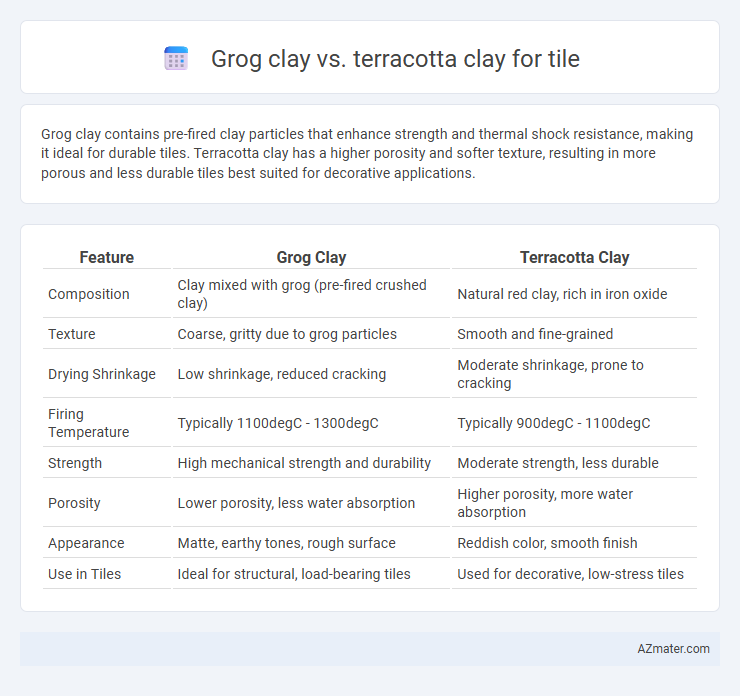Grog clay contains pre-fired clay particles that enhance strength and thermal shock resistance, making it ideal for durable tiles. Terracotta clay has a higher porosity and softer texture, resulting in more porous and less durable tiles best suited for decorative applications.
Table of Comparison
| Feature | Grog Clay | Terracotta Clay |
|---|---|---|
| Composition | Clay mixed with grog (pre-fired crushed clay) | Natural red clay, rich in iron oxide |
| Texture | Coarse, gritty due to grog particles | Smooth and fine-grained |
| Drying Shrinkage | Low shrinkage, reduced cracking | Moderate shrinkage, prone to cracking |
| Firing Temperature | Typically 1100degC - 1300degC | Typically 900degC - 1100degC |
| Strength | High mechanical strength and durability | Moderate strength, less durable |
| Porosity | Lower porosity, less water absorption | Higher porosity, more water absorption |
| Appearance | Matte, earthy tones, rough surface | Reddish color, smooth finish |
| Use in Tiles | Ideal for structural, load-bearing tiles | Used for decorative, low-stress tiles |
Introduction to Grog Clay and Terracotta Clay
Grog clay contains pre-fired clay particles that enhance tile durability and reduce shrinkage during firing, making it ideal for creating robust ceramic tiles. Terracotta clay, characterized by its iron-rich content, produces warm, reddish-orange tiles commonly used in rustic and traditional designs due to its porous nature and earthy texture. Understanding the material composition and firing characteristics of both grog and terracotta clays is essential for selecting the right clay type to achieve specific aesthetic and functional tile properties.
Composition and Material Differences
Grog clay contains pre-fired ceramic particles added to the clay body, enhancing thermal shock resistance and reducing shrinkage during drying and firing, making it ideal for tile production that requires durability and minimal warping. Terracotta clay is primarily composed of natural iron-rich clays fired at lower temperatures, resulting in a porous, reddish-orange body with less grog content, which can lead to higher shrinkage and fragility compared to grog clay. The material difference impacts the tile's strength, texture, and moisture absorption, with grog clay offering greater mechanical stability and terracotta providing traditional, rustic aesthetics.
Tile-Making Properties of Grog Clay
Grog clay enhances tile-making properties by improving thermal shock resistance and reducing shrinkage during firing, making tiles more durable and stable. The inclusion of grog particles increases porosity, allowing better moisture evaporation and minimizing warping or cracking. Terracotta clay typically offers richer color but less mechanical strength compared to the high structural integrity provided by grog clay in tile production.
Tile-Making Properties of Terracotta Clay
Terracotta clay offers superior plasticity and workability compared to grog clay, making it ideal for detailed tile shapes and smooth surfaces. Its fine particle size enhances moisture retention, ensuring even drying and reducing cracking during firing. These properties contribute to durable, lightweight tiles with a warm, rustic appearance commonly used in architectural applications.
Durability and Strength Comparison
Grog clay incorporates pre-fired clay particles that enhance tile durability by reducing shrinkage and cracking during firing, resulting in stronger, more resilient tiles compared to terracotta clay. Terracotta clay, while traditional and aesthetically warm, tends to be softer and more porous, making it less durable and prone to chipping or wear over time. The inclusion of grog improves mechanical strength and thermal shock resistance, which is critical for high-traffic or outdoor tile applications.
Water Absorption and Porosity Factors
Grog clay contains pre-fired particles that reduce water absorption and enhance porosity control in tile production, making tiles more durable and less prone to cracking. Terracotta clay, inherently more porous, exhibits higher water absorption rates that require sealing to prevent moisture damage. The choice between grog and terracotta clay significantly impacts the tile's porosity levels, water resistance, and long-term structural integrity.
Firing Temperatures and Suitability for Tiles
Grog clay contains pre-fired clay particles that increase its thermal shock resistance and reduce shrinkage during firing, making it suitable for tile production at firing temperatures ranging from 1,100degC to 1,250degC. Terracotta clay, with its iron-rich composition, typically fires at lower temperatures between 900degC and 1,100degC, producing porous tiles that are less durable for high-traffic areas. Grog clay's enhanced structural integrity and ability to withstand higher firing temperatures make it preferable for durable, high-quality ceramic tiles.
Color, Texture, and Surface Finish
Grog clay contains pre-fired clay particles that enhance texture by adding coarse, gritty surfaces ideal for rustic tile designs, with natural earthy tones that deepen during firing. Terracotta clay offers a smooth, fine texture with rich reddish-orange hues, producing a classic warm color palette and a matte to semi-gloss surface finish. The choice between grog and terracotta clay affects tile durability and aesthetic, where grog yields more textured, tactile tiles and terracotta provides smoother, uniformly colored surfaces.
Cost and Availability for Tiling Projects
Grog clay is generally more expensive than terracotta clay due to its pre-fired, grog-included composition that enhances durability and reduces shrinkage for tiling projects. Terracotta clay is widely available and more cost-effective, making it a popular choice for budget-conscious tiling, though it may require additional treatment to improve strength. Availability of grog clay can be limited depending on the region, whereas terracotta clay is commonly sourced from local suppliers worldwide.
Best Applications: Choosing Between Grog and Terracotta for Tiles
Grog clay offers enhanced durability and reduced shrinkage, making it ideal for crafting robust, textured tiles suitable for high-traffic areas and outdoor use. Terracotta clay, prized for its rich, warm tones and porous nature, excels in decorative indoor tiles that benefit from its natural breathability and aesthetic appeal. Selecting between grog and terracotta depends on whether tile applications demand structural strength or artistic expression.

Infographic: Grog clay vs Terracotta clay for Tile
 azmater.com
azmater.com